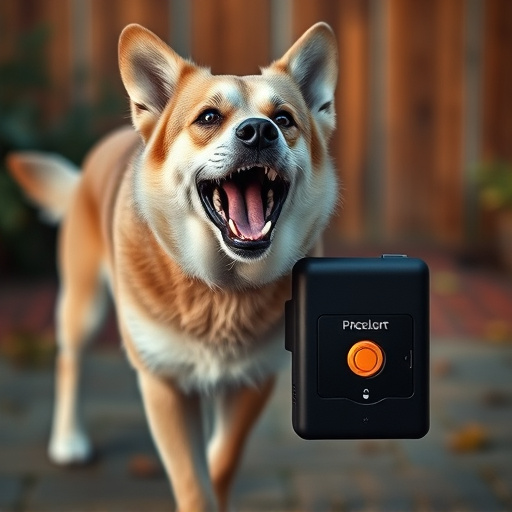Sound wave pet behavior control, leveraging specific sound frequencies to influence animal behavior like barking and aggression, offers a non-invasive alternative to traditional training. Devices mimic distressing environmental sounds as gentle deterrents. The ideal vibration settings for dog repellent devices are fine-tuned using high-tech algorithms that detect animal presence, incorporating ultrasonic tones or high-pitched noises off-putting to dogs. Selection requires tailoring to individual dog sensitivity, age, breed, and temperament, with regular testing in controlled environments to find the "sweet spot" for effective behavior modification without discomfort. Ethical considerations include potential side effects on sensitive animals and lack of regulation, necessitating research into reputable brands and tailored vibration settings.
Unleash the power of sound waves to control your pet’s behavior with our comprehensive guide. Discover how this innovative technology works, from the science behind it to its practical applications in training and repelling unwanted habits. We’ll delve into the importance of selecting the best vibration settings for your dog repellent device, ensuring effective yet ethical pet management. Learn about the latest research and best practices for a harmonious co-existence with your furry friend.
- Understanding Sound Wave Pet Behavior Control: The Science Behind It
- Choosing the Best Vibration Settings for Your Dog Repellent Device
- Effectiveness and Ethical Considerations of Using Sound Waves for Pet Training
Understanding Sound Wave Pet Behavior Control: The Science Behind It
Sound wave pet behavior control is a non-invasive technology that leverages specific sound frequencies to influence animal behavior. The science behind it involves understanding how different vibrations can stimulate or suppress certain responses in pets, such as barking, whining, or aggressive tendencies. By emitting tailored sound waves, these devices mimic natural environmental sounds that dogs and other animals find distressing or unpleasant, effectively acting as a gentle deterrent.
The best vibration settings for dog repellent devices are often fine-tuned to target specific behaviors while minimizing discomfort or stress on the pet. These devices use high-tech algorithms to detect and respond to an animal’s presence, emitting sounds that are safe and effective without causing harm. In many cases, the sound waves are designed to mimic the frequencies that dogs find off-putting, such as high-pitched noises or certain ultrasonic tones. This approach allows for responsible pet behavior management while promoting a calm and balanced living environment for both pets and their owners.
Choosing the Best Vibration Settings for Your Dog Repellent Device
When selecting the best vibration settings for your dog repellent device, it’s crucial to consider your pet’s sensitivity and the specific behavior you’re targeting. Not all dogs react the same way to sound waves, so fine-tuning the vibrations is key. Start with a lower setting and gradually increase until you observe the desired effect without causing discomfort. Factors like your dog’s age, breed, and overall temperament play a significant role in determining the optimal vibration level.
For example, younger or more sensitive dogs might be perturbed by higher frequencies, while larger breeds could require stronger vibrations to be deterred. Regularly testing different settings in controlled environments will help you find the sweet spot that effectively repels unwanted behaviors without causing stress or anxiety.
Effectiveness and Ethical Considerations of Using Sound Waves for Pet Training
The use of sound waves for pet behavior control has gained attention as a potentially effective and non-lethal alternative to traditional training methods. Devices that emit specific frequencies or tones can be particularly useful in modifying pet behaviors, such as barking, howling, or aggression. For example, ultrasonic dog repellent devices, which operate within the high-frequency range that dogs can hear but humans typically cannot, have shown promising results in deterring unwanted canine actions. These devices use the best vibration settings to create an unpleasant sensation without causing harm, making them a popular choice for pet owners looking for humane training tools.
However, ethical considerations surround this technology’s application. While sound wave devices are often marketed as stress-free solutions, their effectiveness may vary among different breeds and individuals. Some animals might be more sensitive or desensitized to certain frequencies, leading to potential side effects. Moreover, the lack of regulation in this industry means that product quality and safety standards can differ. Therefore, pet owners should carefully research and choose reputable brands, ensuring the best vibration settings for their pets’ specific needs to avoid any adverse reactions.
Sound wave pet behavior control offers a non-invasive and humane approach to training animals, leveraging the science behind sound waves and vibration settings. By carefully selecting the ideal vibration settings for your dog repellent device, you can effectively address unwanted behaviors without causing harm or stress. While this method has shown promise in numerous applications, it’s crucial to consider its ethical implications and ensure responsible use. With the right balance of technology and compassion, sound wave technology can foster positive pet behavior changes, making it a valuable tool for pet owners worldwide.
